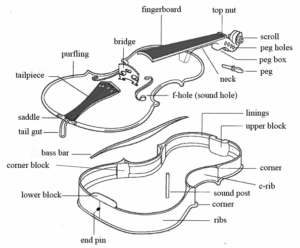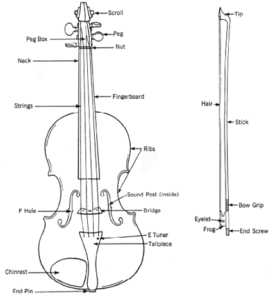
Introduction to Violin Anatomy
The violin, a cornerstone of classical music, has captivated audiences for centuries with its extraordinary sound and versatility. Its significance in the musical world is profound, influencing genres from Baroque to contemporary. The violin’s rich history dates back to the early 16th century in Italy, where luthiers such as Antonio Stradivari, better known as Stradivarius, crafted some of the most exceptional violins ever made. Stradivarius violins are renowned for their unparalleled craftsmanship and exquisite tone, making them highly sought after by musicians and collectors alike.
Understanding the anatomy of the violin is crucial for both novice and advanced players. Each part of the violin, from the body to the bow, plays a vital role in producing its distinct sound. By familiarizing oneself with the instrument’s components, players can achieve better control over their music, enhance their techniques, and perform maintenance with greater confidence. The violin’s intricate design comprises various elements, each contributing to the instrument’s resonance, playability, and overall performance.
Moreover, knowledge of violin anatomy allows for a deeper appreciation of the instrument’s intricate craftsmanship and its historical evolution. It also provides insights into how different components work in concert to create the violin’s unique timbre and dynamics. Whether it is the body, neck, fingerboard, or the bow, each part has a specific function that, when understood, empowers musicians to make more informed decisions regarding repairs, adjustments, and even selecting a new instrument.
This section sets the stage for an in-depth exploration of the violin’s individual components. By delving into the anatomy of the violin, one can gain a comprehensive understanding of how this remarkable instrument produces its enchanting sound and why it continues to be a favorite among musicians worldwide.
Parts of the Violin
A violin is a beautifully complex instrument comprised of numerous components, each playing a critical role in its function and sound production. The main body of the violin consists of the top plate, back plate, and ribs. The top plate (or soundboard) is usually made from spruce, a wood known for its excellent acoustic properties. It amplifies the vibrations produced by the strings. The back plate and ribs are typically crafted from maple, which provides a sturdy structure and contributes to the overall tonal quality.
The neck of the violin extends from the body and supports the fingerboard, which is where the player presses the strings to produce different notes. The fingerboard is usually made from ebony due to its durability and smooth surface. At the top of the neck, you’ll find the pegs housed in the pegbox. These pegs are essential for tuning the instrument, allowing the player to adjust the tension of each string.
The bridge is a small piece of curved wood situated between the F-holes, which holds the strings at the correct height and angle. It plays a pivotal role in transferring the vibrations of the strings to the body of the violin, thereby affecting the sound. Speaking of the F-holes, these are the two openings on either side of the bridge that allow sound to project from the body of the violin.
At the opposite end of the violin from the neck, you’ll find the tailpiece, where the strings are anchored. The tailpiece is often made from the same materials as the fingerboard and integrates fine tuners for more precise tuning adjustments. Positioned near the tailpiece is the chin rest, designed to provide comfort and stability for the player’s chin and jaw.
Understanding these parts and their respective roles can significantly enhance a violinist’s ability to both play and care for the instrument. Visual aids and diagrams are particularly beneficial in illustrating the anatomy of the violin, making it easier for learners to grasp the intricacies of this timeless instrument.
Understanding the Bow
The violin bow is an integral component of a violinist’s toolkit, playing an essential role in shaping the instrument’s sound. The anatomy of the bow can be divided into several key parts: the stick, frog, screw, and the hair.

The stick is the bow’s backbone, typically made from pernambuco or brazilwood. Pernambuco is preferred by many professional violinists due to its high density and excellent elasticity, which facilitate a smooth, nuanced performance. Brazilwood, on the other hand, is a more affordable alternative, offering decent flexibility and strength.
Next is the frog, the part of the bow that is held by the violinist. Often crafted from ebony for its durability and aesthetic appeal, the frog is mounted with a metal ferrule and an eyelet. The design and weight of the frog are critical, as they influence the balance and control a player has over the bow.
The screw, also known as the adjuster, is at the end of the bow and is responsible for tightening or loosening the bow hair. Proper bow tension is vital not only for sound quality but also for the longevity of the bow. A well-adjusted screw ensures that the bow hair lies flush against the strings, facilitating an even sound production.
Finally, the hair, traditionally sourced from horsehair, is stretched between the frog and the tip. High-quality horsehair has tiny barbs along its shaft, allowing it to grip the violin strings properly. Synthetic alternatives are available but often lack the nuanced grip provided by natural horsehair.
Maintaining a violin bow is paramount to preserving its functionality and performance characteristics. Regular rehairing, typically every six to twelve months, ensures consistent playability. Additionally, violinists should always loosen the bow when not in use to prevent undue stress on the stick and hair. Periodic cleaning of the stick and frog, and keeping the bow away from extreme temperatures and humidity, are simple yet effective practices that contribute to the bow’s longevity.
In conclusion, understanding the distinct components of the violin bow and their respective roles allows musicians to make informed choices about their equipment. Proper maintenance and care can significantly enhance the overall playing experience, ensuring a harmonious relationship between the violinist and their instrument.
Caring for Your Violin and Bow
Proper maintenance of both the violin and bow is essential to preserving their sound quality and longevity. Daily care routines play a critical role in ensuring that these instruments continue to perform at their best. One fundamental practice involves cleaning the violin and bow hair after each practice session. Utilize a soft cloth to gently remove any rosin dust and fingerprints from the body and strings of the violin. Similarly, the bow hair should be wiped down carefully to eliminate excess rosin, ensuring consistent performance.
In addition to daily care, more in-depth maintenance practices are crucial. The violin strings should be changed regularly, typically every three to six months, depending on the frequency of use. Fresh strings sustain better tonal quality and responsiveness. When changing strings, it is advisable to replace them one at a time to maintain the tension on the instrument and prevent any damage to the bridge or soundpost.
Re-hairing the bow is another vital aspect of violin care, usually recommended every six to twelve months. Over time, the bow hair loses its grip on the strings, affecting sound production. A qualified luthier should handle the re-hairing process to ensure optimal results without causing damage to the bow.
Safe storage practices are equally important in maintaining the integrity of the violin and bow. Always store them in a climate-controlled environment to avoid exposure to extreme temperatures and humidity, which can cause the wood to warp or crack. Utilize a high-quality case that offers adequate protection during transport and storage.
Several products can aid in the upkeep of your violin and bow. For cleaning, consider using specialized violin cleaners and polishes designed to preserve the finish without causing harm. Rosin is also a critical component for maintaining bow hair quality; select a type suitable for your playing style and violin.
Ultimately, professional services from experienced luthiers can provide invaluable support in addressing any significant issues and conducting routine maintenance. Regular check-ups by a luthier can help identify potential problems early, ensuring that your violin and bow remain in optimal condition for years to come.



